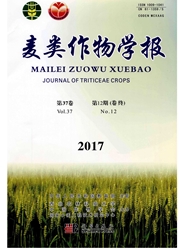

 中文摘要:
中文摘要:
Nitric oxide (NO) is a key signaling molecule in different physiological processes of plants, including programmed cell death (PCD). PCD of tillers plays an important role in surviving which are major components of grain yield. PCD was triggered in wheat leaves of main stem and tillers by NO content under different nitrogen treatments. In wheat, NO could be synthesized endogenously by nitrate reductase (NR). As an inducible enzyme, NR activity was closely related to substrate concentration. Therefore, different nitrogen levels would change NR activity and NO production. The objective of this study was to determine the effects of NR activity, NO production, and the correlation between them on different tillers growth, development, senescence, and kernel protein content under different nitrogen levels. Field-experiments were conducted in 2009-2011 growing seasons, using two wheat cultivars with different spike-types. Results showed that for main stem and primary tillers, NR activity and NO content reached high level at heading stage, while for secondary tiller, the level of NR activity was low, but NO content was high in the present research. The NO synthesis depending on NR activity in wheat leaves was significant in the early growing stage, but the NO synthesis weakened with the progress of growing period. NO was related to the senescence of wheat leaves, but PCD was more sensitive to marked changes of NO content than NO content itself. N application had marked influence on the aging process of primary tiller, while had little influence on that of main stem and secondary tiller. Moreover, N fertilizer application could increase spike rate and protein content of primary tiller by N fertilizer application.
 英文摘要:
英文摘要:
Nitric oxide (NO) is a key signaling molecule in different physiological processes of plants, including programmed cell death (PCD). PCD of tillers plays an important role in surviving which are major components of grain yield. PCD was triggered in wheat leaves of main stem and tillers by NO content under different nitrogen treatments. In wheat, NO could be synthesized endogenously by nitrate reductase (NR). As an inducible enzyme, NR activity was closely related to substrate concentration. Therefore, different nitrogen levels would change NR activity and NO production. The objective of this study was to determine the effects of NR activity, NO production, and the correlation between them on different tillers growth, development, senescence, and kernel protein content under different nitrogen levels. Field-experiments were conducted in 2009-2011 growing seasons, using two wheat cultivars with different spike-types. Results showed that for main stem and primary tillers, NR activity and NO content reached high level at heading stage, while for secondary tiller, the level of NR activity was low, but NO content was high in the present research. The NO synthesis depending on NR activity in wheat leaves was significant in the early growing stage, but the NO synthesis weakened with the progress of growing period. NO was related to the senescence of wheat leaves, but PCD was more sensitive to marked changes of NO content than NO content itself. N application had marked influence on the aging process of primary tiller, while had little influence on that of main stem and secondary tiller. Moreover, N fertilizer application could increase spike rate and protein content of primary tiller by N fertilizer application.
 同期刊论文项目
同期刊论文项目
 同项目期刊论文
同项目期刊论文
 Changes of glutenin subunits due to water–nitrogen interaction influence size and distribution of gl
Changes of glutenin subunits due to water–nitrogen interaction influence size and distribution of gl 期刊信息
期刊信息
